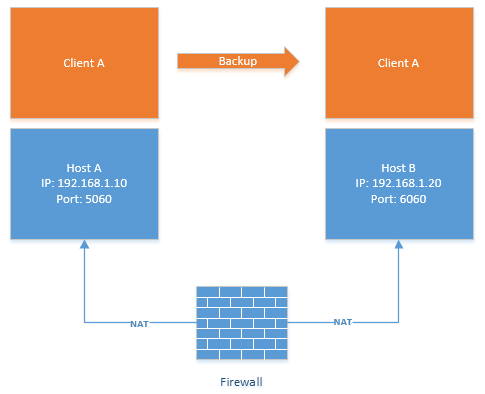Separate host and user configurations in 3CX Phone System v14
In 3CX Phone System v14, in order to ensure fault tolerance and easy migration of user PBXs, a separation was made between the server (host and network) configuration on which the system is running and the configuration of a specific user PBX. This allows you to solve a number of important tasks:
Transferring PBX configuration between servers can be compared with the migration of virtual machines between supervisors. The configuration of the user PBX - parameters of extensions, IP phones, routing rules, etc., now does not depend on the network environment of the server to which the PBX is transferred. Using automatic DNS update, you can restore or transfer the system almost imperceptibly to users.

The following types of migration are possible for an organization’s PBX (see figure)
Let us consider in more detail what the host configuration and the configuration of the user PBX include.
The host configuration contains the information you specified when you first installed 3CX Phone System on the server, and some of the parameters specified after installing the server in the 3CX management console. Host parameters are divided into static and dynamic.
Static host settings cannot be changed after installing the 3CX server. To change them, you need to reinstall the server.
')
Dynamic, i.e. Parameters that can be changed by the host can be changed by the administrator after installing the server. However, in some cases, you will need to change the settings of the firewall or re-configure the IP phones.
The configuration of the user PBX contains all the parameters of a specific 3CX system, including the username and password of the administrator. Therefore, the PBX administrator credentials are also transferred to another host. The configuration includes:
As mentioned, when transferring the PBX configuration to a new server, the host configuration is not transferred. Therefore, if you need to transfer a PBX to a host using SIP port 6060, proceed as follows:
- In the event of a system failure, quickly transfer the organization's PBX configuration to another prepared server.
- Easy migration of an organization's PBX from a local server to the cloud (to a virtual PBX) and vice versa.
- Convenience of preliminary testing of system updates due to simple transfer of the working configuration to the test server.
Transferring PBX configuration between servers can be compared with the migration of virtual machines between supervisors. The configuration of the user PBX - parameters of extensions, IP phones, routing rules, etc., now does not depend on the network environment of the server to which the PBX is transferred. Using automatic DNS update, you can restore or transfer the system almost imperceptibly to users.

The following types of migration are possible for an organization’s PBX (see figure)
- Host A to Host B
- From host B to host A
- From host A or B to 3CX Virtual PBX (in any free slot)
- From 3CX Virtual PBX to Host A or B
Let us consider in more detail what the host configuration and the configuration of the user PBX include.
Host configuration
The host configuration contains the information you specified when you first installed 3CX Phone System on the server, and some of the parameters specified after installing the server in the 3CX management console. Host parameters are divided into static and dynamic.
Static parameters
Static host settings cannot be changed after installing the 3CX server. To change them, you need to reinstall the server.
')
- Setup Mode - Split DNS / Internal External FQDN / Internal IP
- Used web server (IIS or Abyss)
- Web server ports
- FQDN name
- Self-signed SSL security certificate
Dynamic parameters
Dynamic, i.e. Parameters that can be changed by the host can be changed by the administrator after installing the server. However, in some cases, you will need to change the settings of the firewall or re-configure the IP phones.
- External IP Address
- SIP and RTP ports
- 3CX tunnel port and password
- Mail Server Settings
- E-mail address of the administrator
User PBX configuration
The configuration of the user PBX contains all the parameters of a specific 3CX system, including the username and password of the administrator. Therefore, the PBX administrator credentials are also transferred to another host. The configuration includes:
- Users (extensions)
- Groups and user rights
- IP phone data and auto setup options
- System extensions — queues and call groups, voice menus and voice mail
- General system parameters (interface PBX section)
- Address Books
- SIP trunk and PSTN gateway configuration
- Settings for incoming and outgoing rules
- PBX admin username and password
Configuration Transfer Example
As mentioned, when transferring the PBX configuration to a new server, the host configuration is not transferred. Therefore, if you need to transfer a PBX to a host using SIP port 6060, proceed as follows:
- Install PBX and go through the initial setup wizard.
- Log into the management console and in the Settings - Network - Ports section, specify a new SIP port
- Restore the backup system, in accordance with the documentation
Additional Information
Source: https://habr.com/ru/post/282287/
All Articles